The balance sheet is one of the main financial reports for any business. It shows what a company owns, what they owe, and how much they and others have invested in the business. One of its characteristics is how it separates what you own and what you owe — a.k.a. your assets and liabilities — into two categories based on timeframe.
Current vs. Long-Term
You may have seen the Assets section of your balance sheet divided into two sections: “Current Assets,” and a list of long-term assets that might include Property, Plant, and Equipment; Intangibles; Long-Term Investments; and Other Assets. Let’s break each of these sections down.
Current Assets
Current assets include all the items the business owns that can easily be converted to cash within a year’s time. The most common types of current assets include balances in checking and savings accounts, accounts receivable, and inventory for sale.
Long-Term Assets
The remaining assets are long-term, or assets that cannot easily be converted to cash within a year. Property, Plant, and Equipment, also termed Fixed Assets, includes buildings, automobiles, and machinery that the business owns. You might also see an account called Accumulated Depreciation; it reflects the fact that fixed assets lose their value over time, and adjusts the balance accordingly.
In addition are intangible assets, which have value but no physical presence. The most common intangible assets are trademarks, patents, and Goodwill, which arises if you purchase another company. Investments that are not easily liquidated will also be listed under Long-Term Assets.
Current Liabilities
Similarly, the balance sheet breaks down liabilities into the two categories, current and long-term.
Current liabilities are made up of credit card balances, accounts payable, and any unpaid wages and payroll taxes. If you’ve borrowed money from a bank or mortgage broker, the loan will show up in two places — the amount due within one year will show up in current liabilities, and the amount due after one year will show up in long-term liabilities.
Long-Term Liabilities
The most common types of long-term liabilities are notes payable that are due after one year, such as lease obligations, mortgages, bonds payable, and pension obligations.
Why All the Fuss Over Current vs. Long-Term?
Bankers and investors want to know how liquid a company is, and comparing current assets to current liabilities is a good indicator of that. Especially relevant is how some small businesses have loan covenants requiring they maintain a certain current ratio, or else the bank will call their loan. The current ratio of your business is equal to current assets divided by current liabilities. Bankers like this amount to meet or exceed 1.2 : 1, although this can vary by industry.
Next time you receive a balance sheet from your accountant, check out your current and long-term sections so you’ll gain a better understanding of this report. And don’t hesitate to contact us at Innovative Financial Services, LLC if you need any help with this.

